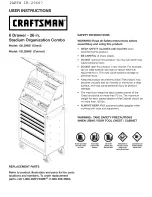
way that only the public key can be used to encrypt messages and only the
corresponding private key can be used to decrypt them.
The following characteristics of encryption create special considerations:
Security exposures
Occurs when an unauthorized person has access to the plain text
encryption key and the cipher text.
Data loss
Occurs if all copies of the decryption key are lost. If you lose the
decryption key, you cannot decrypt the associated ciphertext. The data that
is contained in the ciphertext is considered cryptographically erased. If the
only copies of data are cryptographically erased ciphertext, access to that
data is permanently lost.
To preserve the security of encryption keys, many implementation techniques can
be used to ensure the following conditions:
v
No one individual has access to all the information that is necessary to
determine an encryption key.
– If only the symmetric encryption algorithm is used, manage encryption keys
so that the data key that is used to encrypt and decrypt data is encrypted or
wrapped with a wrapping key that is used to encrypt and decrypt data keys.
To decrypt the ciphertext in this case, the wrapping key is first used to
decrypt the ciphertext data key and obtain the plaintext data key, which is
then used to decrypt the ciphertext and obtain the plaintext. If one unit stores
the wrapping keys and a second unit stores the encrypted data key, then
neither unit alone has sufficient information to determine the plaintext data
key. Similarly, if a person obtains access to the information that is stored on
either unit but not both units, there is not sufficient information to determine
the plaintext data key. The unit that stores the wrapping keys is referred to as
a key server and the unit that stores or has access to the encrypted data keys
is referred to as a storage device. A
key server
is a product that works with the
encrypting storage device to resolve most of the security and usability issues
that are associated with the key management of encrypted storage. However,
even with a key server, there is at least one encryption key that must be
maintained manually. For example, the overall key that manages access to all
other encryption keys.
v
More than one individual has access to any single piece of information that is
required to determine an encryption key. For redundancy, you can do the
following actions:
– Use multiple independent key servers that have multiple independent
communication paths to the encrypting storage devices.
– Maintain backups of the data on each key server. If you maintain backups,
the failure of any one key server or any one network does not prevent storage
devices from obtaining access to data keys that are required to provide access
to data.
– Keep multiple copies of the encrypted data key.
Tivoli Key Lifecycle Manager
The DS8000 supports data encryption with the use of Tivoli Key Lifecycle Manager
and the IBM Full Disk Encryption feature.
Chapter 3. Data management features
71
Summary of Contents for DS8700
Page 2: ......
Page 8: ...vi Introduction and Planning Guide...
Page 10: ...viii Introduction and Planning Guide...
Page 20: ...xviii Introduction and Planning Guide...
Page 22: ...xx Introduction and Planning Guide...
Page 44: ...22 Introduction and Planning Guide...
Page 142: ...120 Introduction and Planning Guide...
Page 160: ...138 Introduction and Planning Guide...
Page 212: ...190 Introduction and Planning Guide...
Page 218: ...196 Introduction and Planning Guide...
Page 224: ...202 Introduction and Planning Guide...
Page 242: ...220 Introduction and Planning Guide...
Page 254: ...232 Introduction and Planning Guide...
Page 255: ......
Page 256: ...Printed in USA GC27 2297 09...
















































